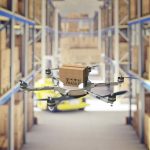 If you used the media to understand the world, then your perception of drones is probably revolving around the delivery of goods, and maybe people. In reality however, the initial implementations of drone technology have typically been in inspection type roles.
If you used the media to understand the world, then your perception of drones is probably revolving around the delivery of goods, and maybe people. In reality however, the initial implementations of drone technology have typically been in inspection type roles.
For instance, Sharper Shape work with utilities to allow inspections to be carried out remotely, whilst Pro Drone provide similar services for the inspection of wind farms. Drones have even been used to monitor fracking sites for the gas emitted, whilst I wrote recently about a University of Aberdeen paper on the role of drones in pipeline monitoring and inspection.
EY’s application of drone technology is very much in keeping with this ‘dull but useful’ theme. They’ve recently launched a global proof of concept to use drones to inspect inventory levels as part of their audit work. The hope is that drones will allow for both more frequent inspections, but also more accurate data collection.
Drone inspectors
The drone platform will provide real-time inventory quantity analysis by reading the QR/barcode/rack labels attached to items and feeding this directly into the platform EY uses to conduct its audits around the world.
The network will initially be deployed in the manufacturing and retail sectors. For instance, in manufacturing, EY plan to use drones to conduct an automated count of vehicles, whilst in retail, drones could be used to conduct a warehouse stock count.
“We have been testing the use of drones in the audit process for several months and the findings have been compelling. It’s now time to scale our testing globally across multiple sectors, as we know that many audits can benefit from the use of this innovative technology. It’s just one of many ways that we are working to embed the very latest technologies into our audit processes to further improve audit quality,” EY’s Hermann Sidhu says.
EY hope that the use of drones will allow much more data to be captured, and thus to free human audit teams up to examine areas of risk rather than the more mundane task of stock taking. Innovating the stock count process using ground breaking drone technology, AI and machine learning, will create a capability that can further benefit EY audit stakeholders.
“We are investing heavily in the development of new technologies that can enhance the quality of our audit process. Our primary function is to build trust and confidence in the capital markets, and digitalizing these types of tasks in our audits means that we can improve not only audit quality, but also provide deeper business insights that further benefit our stakeholders,” the company say.